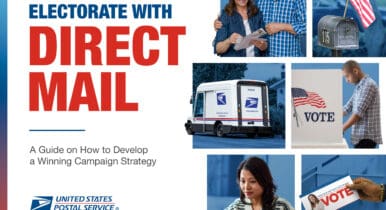What’s Influencing Political Design? The AOC Aesthetic is in Demand and Even Vaporwave is Creeping in.

C. Bakari Kamau II, the art director at the newly unveiled Campaign X Co, didn’t start out working in Democratic politics. In fact, his first taste of designing direct mail was for a Republican shop nearly a decade ago. Back then he needed the work and they needed the help.
When he interviewed in 2018 for a production manager position with Chadderdon Lestingi, the predecessor of Campaign X Co, he told managing partners Liz and Joe about that needs-based decision. They opted to look past that period in Kamau’s two-decade creative career, which also includes stints designing for the Corporation for Public Broadcasting and the National Network to End Domestic Violence.
Having started with the mail shop in a production role, he’s now leading its creative processes. In a conversation with C&E, the Fairfax, Va.-based Kamau talked about the latest political design trends, how to avoid common design mistakes and what he sees as the next frontier.
Q: What’s the hottest political design trend at the moment?
Kamau: If you are a Democrat and you want to signal progressive values, everybody is still really, really into the [Alexandria] Ocasio-Cortez derivative tilted logo. It’s as if you can’t be taken seriously as a progressive if your logo doesn’t look like hers. That’s a testament to her star power, I would say.
If you’re a middle-of-the-road Democrat, I’ve noticed there’s been a push to reclaim the flag and to not really shy so much away from the red, white and blue logos that used to dominate the political sphere. We can wave the flag, but not do it in a disingenuous way.
There’s also the vaporwave design trend — this is something that’s kind of happening outside of political design. It’s a nostalgic exploration of 80s themes and the thing that kicked it off was Stranger Things with the intro music. So there’s a whole world of 80s revivalism in music, art, and fashion that has exploded and is starting to creep its way into political logos.
Younger candidates are adopting vaporwave trends and doing neon logos — colors you wouldn’t expect. [Delegate candidate] Joshua Cole in Virginia comes to mind. His palette is dark purple and neon green. Totally welcome and very refreshing. His logo is going to stand out in the crowd.
Q: Should all candidates be embracing this new aesthetic?
Kamau: My advice is to embrace your most authentic self because anything else won’t come from a place of comfort and it will be obvious to people on the outside that you are wearing a facade that you are not comfortable in. Are you OK with not having a red, white and blue logo? Do you just want to abandon that entirely? What is most reflective of you?
I think that is where the winning path lies. You’re at your best when you’re representing yourself in your most authentic light. In this post-truth era, we’re craving people who radiate authenticity and are able to embrace and be proud of who they are. I think that’s kind of where the secret sauce is.
Q: What are common design mistakes that you see?
Kamau: One mistake that everybody makes, and we’re even trying our best to correct, is too much text. Unfortunately, people just don’t want to read all that and when I say ‘all that,’ I mean more than 50-to-100 words. Just getting the eyeballs to stay put and then reading the piece — that’s a tall ask to make.
And if people think that direct mail is a waste of time, then I’ve got bad news for your digital ad. Scrolling by is even more efficient than throwing away a piece of paper. We just don’t have a lot of time to make an impression so the more focused your message and the more brief and engaging you can make it, the better off you’re going to be.
Q: What’s the next frontier for political design?
Kamau: I don’t think gradients in political logos are going away, because that trend is being driven by broader 80s and 90s revivalism trends like vaporwave. Politicians will continue growing their brands on social media platforms, with increasing engagement, especially as we elect younger candidates. Finally, direct mail won’t disappear because even though it’s old school, it’s highly targeted and still accessible to campaigns with smaller budgets.


